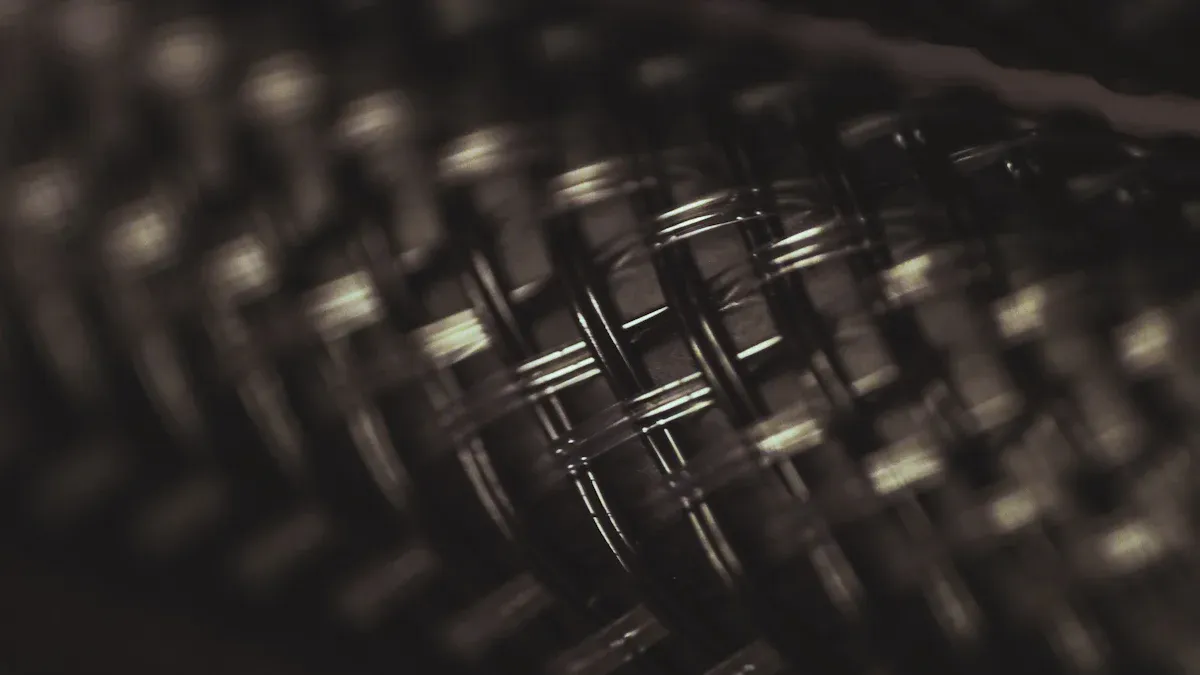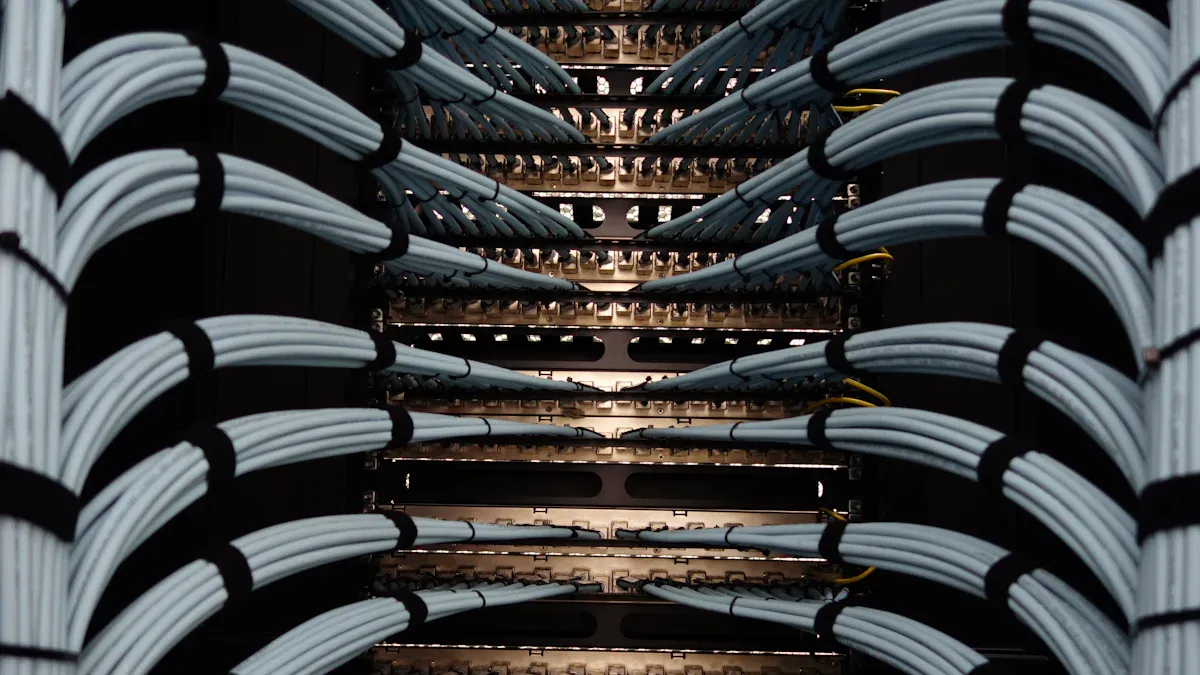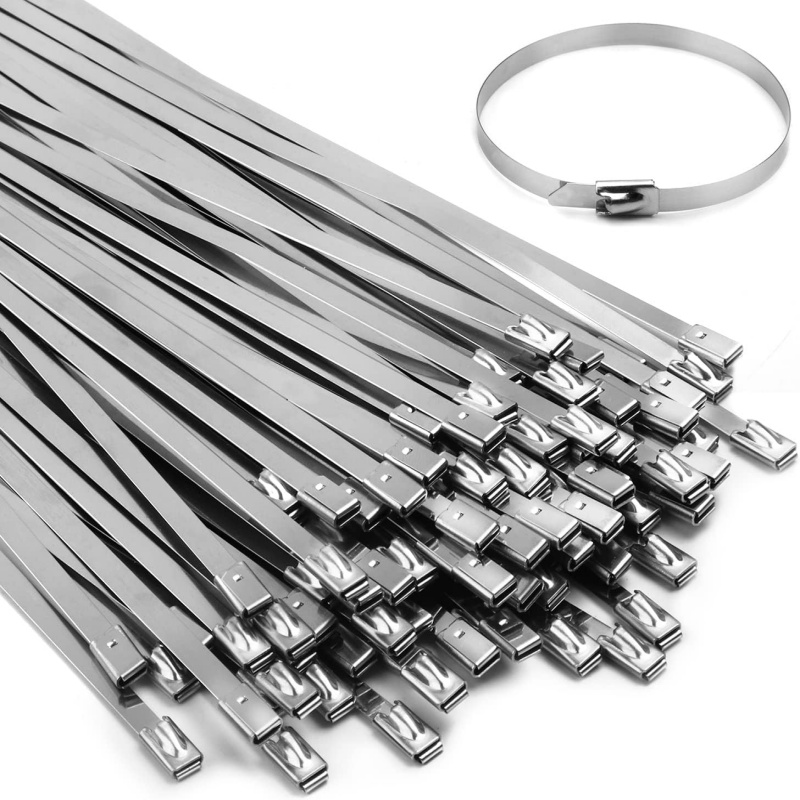
Cable failures in critical systems can lead to severe disruptions and financial losses. For instance:
- Between 2024 and 2035, approximately 3,600 failures could cost EUR 61.5 billion.
- Annual cable break rates range from 0.017% to 0.033% per kilometer.
Stainless steel cable ties with anti-vibration features enhance reliability, reducing risks in essential applications like data centers and telecommunications.
Key Takeaways
- Stainless steel cable ties with anti-vibration parts make systems safer.
- New designs and materials in these ties stop vibrations, helping cables last longer and need fewer repairs.
- Strong locks keep cables in place, even in shaky areas like planes or offshore sites.
The Problem with Cable Vibrations
Causes of Cable Vibrations
Cable vibrations arise from various environmental and operational factors. In industrial settings, external forces such as wind and rain often trigger oscillations. Studies have shown that specific wind speeds, ranging from 29 to 48 km/h, can cause cables to vibrate, especially when combined with water on the surface. This phenomenon, known as rain-wind-induced vibration, has been observed in structures like the Meikonishi cable-stayed bridge. Additionally, vortex excitation and aerodynamic forces contribute to instability, particularly in cables exposed to high winds or grouped configurations.
Operational factors also play a significant role. Continuous movement or rapid shifts in industrial environments can loosen cable connections, leading to signal transmission loss. Inadequate shielding further exacerbates the problem, causing noise and interference. These issues highlight the importance of robust solutions, such as stainless steel cable ties, to secure cables and minimize vibration-related risks.
Consequences of Cable Failures
Unaddressed cable vibrations can lead to severe consequences. Over time, vibrations accelerate friction damage in wire ropes, degrading their mechanical properties. This process often results in structural deformation and fractures under tensile loads. Studies have revealed that repeated bending and shock loading exacerbate wear, reducing performance and increasing the likelihood of failure.
In critical applications, such as cable-supported bridges or industrial systems, these failures can compromise safety and reliability. Aeolian vibrations, for instance, can cause fatigue damage in overhead conductors, leading to strand wear and eventual breakage. Proper inspection and maintenance protocols are essential to mitigate these risks and ensure the longevity of cable systems.
Breakthrough #1: Vibration Dampening Design in Stainless Steel Cable Ties
Innovative Design Features
Modern stainless steel cable ties incorporate advanced vibration-dampening features that address the challenges posed by high-vibration environments. These ties utilize specialized materials and structural innovations to absorb and dissipate vibrational energy effectively. For instance, designs inspired by aviation technology have introduced flexible yet durable components that prevent excessive oscillations.
| Source | Description |
|---|---|
| The Evolution of Aviation Cable Ties | Highlights material and design innovations that absorb vibrations, extending cable lifespan. |
| Retrofitting of Cables with Damper Systems | Explains how dampers mitigate vibrations, maintaining structural integrity in cable systems. |
These design advancements ensure cables remain secure and functional, even in demanding conditions.
Mechanism for Reducing Cable Stress
Anti-vibration stainless steel cable ties reduce cable stress through innovative damping mechanisms. These include detuning pendulums, AR twister dampers, and Stockbridge dampers. Each system targets specific vibration types, such as aeolian or galloping vibrations, to minimize mechanical strain.
| Damper Type | Description |
|---|---|
| Detuning Pendulum | Mitigates vibrations by separating frequencies of vertical and torsional movements. |
| AR Twister Dampers | Reduces aerodynamic lift by causing the conductor to rotate, controlling galloping and aeolian vibrations. |
| Stockbridge Damper | Dissipates oscillation energy effectively, eliminating wind-induced vibrations. |
These mechanisms ensure consistent tension and stability, preventing damage caused by prolonged stress.
Benefits for Cable Longevity
Stainless steel cable ties significantly enhance cable longevity by reducing wear and tear caused by vibrations. Their robust construction and resistance to environmental factors make them ideal for harsh conditions. Industries requiring high tensile strength, such as aviation and construction, increasingly adopt these ties for their durability and reliability.
- The market for uncoated stainless steel cable ties continues to grow due to their durability.
- These ties outperform traditional plastic alternatives in extreme environments.
- Their superior strength and corrosion resistance ensure long-term performance.
By extending the lifespan of cables, these ties reduce maintenance costs and improve system reliability.
Breakthrough #2: Advanced Stainless Steel Material Composition
Durability of 304 and 316-Grade Stainless Steel
304 and 316-grade stainless steel offer exceptional durability, making them ideal for cable ties in demanding environments. These grades resist mechanical stress and maintain structural integrity under heavy loads. 316-grade stainless steel, enriched with molybdenum, provides enhanced strength and resilience compared to 304-grade. Industries requiring high tensile strength, such as aerospace and construction, rely on these materials for their ability to withstand prolonged use without deformation.
Manufacturers of stainless steel cable ties prioritize these grades due to their proven performance in applications requiring long-term reliability. Their robust composition ensures cables remain secure, even in high-vibration settings. This durability reduces the need for frequent replacements, lowering maintenance costs and improving operational efficiency.
Resistance to Corrosion and Extreme Conditions
Stainless steel cable ties excel in resisting corrosion and extreme conditions. Their passive chromium oxide film protects against environmental damage, including exposure to moisture, salt, and chemicals. In corrosive mediums containing halogen anions like chloride and bromide, pitting corrosion can occur. However, adding molybdenum and controlling halogen ion concentration mitigates this risk.
| Evidence Description | Key Points |
|---|---|
| Pitting Corrosion | Occurs in specific corrosive mediums, particularly with halogen anions like chloride and bromide. |
| Active-Passive Corrosion Cell | Damage to the passive film leads to localized corrosion, resulting in pitting. |
| Prevention Methods | Use stainless steel with molybdenum and chromium, control halogen ion concentration, and add corrosion inhibitors. |
These properties make stainless steel cable ties indispensable in industries exposed to harsh environments, such as marine engineering and chemical processing.
Applications in Harsh Environments
Stainless steel cable ties demonstrate unmatched performance in harsh environments. Their resistance to extreme temperatures, UV radiation, and chemical exposure ensures reliable cable management in challenging conditions. Applications include securing cables in offshore platforms, industrial plants, and outdoor installations.
In offshore oil rigs, stainless steel cable ties withstand saltwater corrosion and high-pressure conditions. In chemical plants, their resistance to reactive substances ensures cables remain intact and functional. Outdoor installations benefit from their ability to endure temperature fluctuations and prolonged exposure to sunlight. These versatile applications highlight the importance of advanced material composition in ensuring safety and reliability.
Breakthrough #3: Secure Locking Mechanisms in Stainless Steel Cable Ties

Prevention of Slippage and Cable Movement
Secure locking mechanisms in stainless steel cable ties play a critical role in preventing slippage and unwanted cable movement. These mechanisms are engineered to hold cables firmly in place, even in high-vibration environments. By maintaining a tight grip, they reduce the risk of accidental disconnections, which is vital in applications like data centers where uninterrupted connectivity is essential. Locking systems also ensure that connectors remain securely mated, safeguarding signal transmission and protecting equipment from damage caused by shocks or vibrations. This reliability makes them indispensable in industries requiring stable and secure cable management solutions.
Consistent Tension for Stability
Consistent tension is a cornerstone of cable stability, and stainless steel cable ties excel in maintaining it. Their robust design ensures uniform pressure across the cable bundle, minimizing the risk of loosening over time. This stability is particularly important in environments subject to dynamic forces, such as industrial machinery or transportation systems.
| Measurement Unit | Implication for Cable Tension |
|---|---|
| Tension Ratio (%) | A ratio of 100% indicates maximum allowable tension, while below 100% suggests a safe margin. |
| Hertz (Hz) | Higher frequencies may indicate higher cable tension, while lower frequencies suggest lower tension. |
| Pascal (Pa) | Higher pressure values may indicate higher cable tension, while lower values suggest lower tension. |
| Mass (kg, lb) | Higher mass values indicate higher cable tension, while lower values correspond to lower tension. |
This ability to maintain consistent tension not only enhances cable performance but also extends the lifespan of the entire system by reducing wear and tear.
Use Cases in High-Vibration Industries
Industries operating in high-vibration environments rely heavily on stainless steel cable ties with secure locking mechanisms. In aerospace, these ties ensure that critical wiring systems remain intact during flight, where vibrations are constant. In automotive manufacturing, they prevent cable displacement in assembly lines and vehicles. Offshore oil rigs also benefit from their ability to withstand the combined challenges of vibration, saltwater exposure, and extreme temperatures. These versatile applications highlight the importance of secure locking mechanisms in ensuring operational safety and efficiency across various sectors.
The three breakthroughs in anti-vibration stainless steel ties revolutionize cable management by enhancing safety, reliability, and cost efficiency.
- Self-locking mechanisms eliminate tool dependency, ensuring secure holds without slippage.
- High tensile strength reduces breakage risks, improving safety.
- Corrosion resistance and durability ensure long-term performance in harsh environments.
These innovations pave the way for safer, more efficient cable systems across industries.
FAQ
What makes stainless steel cable ties better than plastic ones?
Stainless steel ties offer superior durability, corrosion resistance, and tensile strength. They perform reliably in extreme environments, unlike plastic ties, which degrade under harsh conditions.
Can stainless steel cable ties handle high-vibration environments?
Yes, their advanced locking mechanisms and vibration-dampening designs ensure stability. These features prevent slippage and reduce stress, making them ideal for high-vibration industries.
Are stainless steel cable ties reusable?
Most stainless steel cable ties are single-use due to their secure locking mechanisms. However, some manufacturers offer reusable options for specific applications requiring flexibility.
Post time: Apr-10-2025
